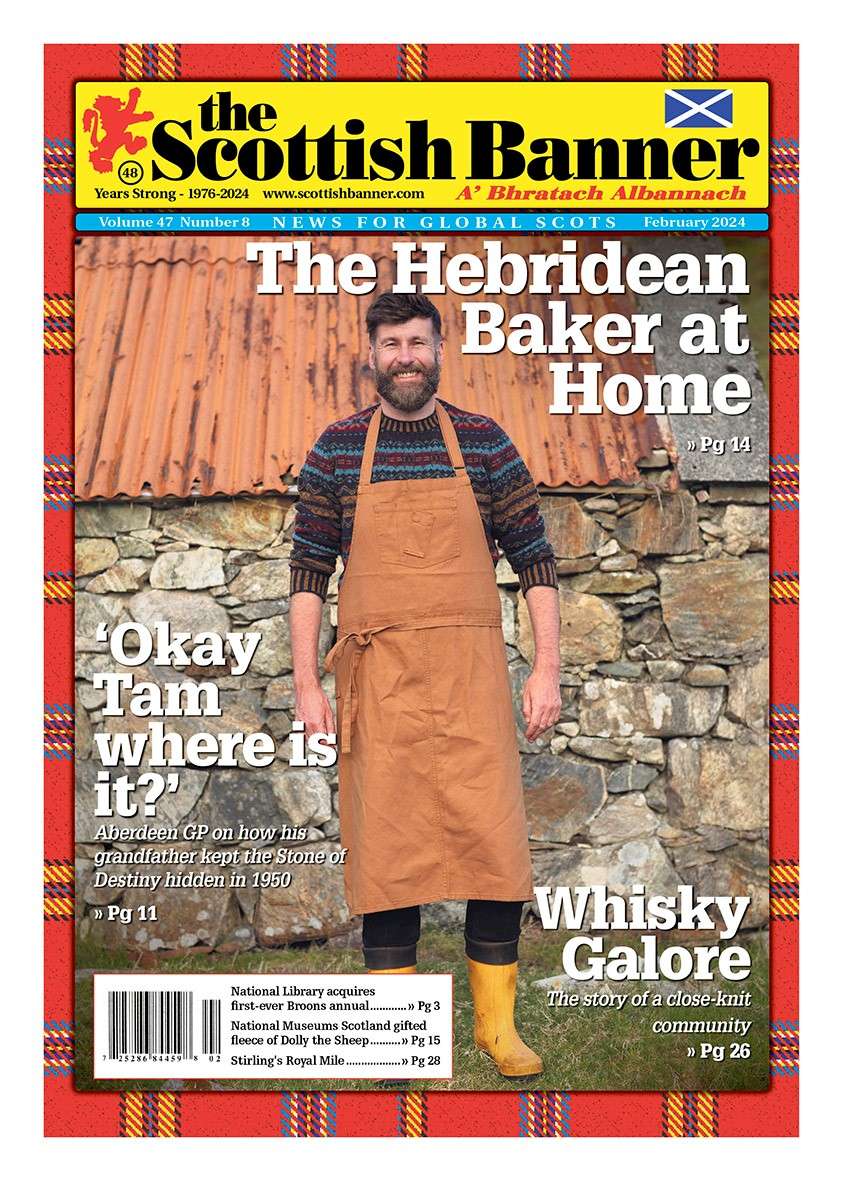February – 2024 (Vol. 47, Number 08)
The Banner Says…
Scottish leap year traditions
-

Bestselling author Coinneach MacLeod, The Hebridean Baker.
This month may be the shortest one of the year, but we do get one extra day with 29 days on this leap year.
The first leap year in the modern sense in Britain was in 1752, when 11 days were ‘lost’ from the month of September with the adoption of the Gregorian calendar by Britain and the British colonies.
Marriage proposal
In Scotland, a strange custom developed on a leap year where women could ask a man for his hand in marriage. The woman was supposed to wear a red or scarlet coat on the day of the proposal. It is thought the idea originated in Ireland in the 5th century when St Brigid asked St Patrick to allow women to be able to propose to men, as some women felt they had to wait too long for a matrimony request.
The custom is believed to have been brought to Scotland by Irish monks. Whilst this may not seem strange today back in Scottish history it was actually illegal for a woman to propose, except every four years at leap year day. It was Queen Margaret of Scotland who passed a law in 1288 that any man who refuses a Leap Day proposal should be fined, with the penalty anything from £1 to a silk gown (so it might be bad luck for anyone rejecting their sweetheart on 29 February). So, no pressure for the chap that had the question popped to them!
Should you be a lady, and a traditionalist, and not have a suitable gentleman to ask for his hand in marriage this month, I am afraid your next opportunity will not be until 2028, or if you are very choosy perhaps you will need to wait to 2032 or 2036 which are also upcoming leap years.
Leapling
Should a marriage proposal be excepted on February 29th Scots traditionally avoided getting married on that date as it brought bad luck to the marriage and often divorce. Scots also considered it to be unlucky to be born on a leap day. It was thought that “leapling” or a leap baby were more difficult to raise and often unwell. However according to astrologers, babies born on February 29 (Pisceans) will grow up to have unique talents, including a great deal of creativity and the ability to give sound advice.
Scottish farmers worry about their crops and livestock on a leap year. The Farmer’s Magazine of 1816 reported that in Scotland: ‘leap year never was a good sheep year’ and it is thought to bring bad luck to farmers, especially for sheep farmers.
In this issue
One person who will be glad it is a leap year to keep up with his busy schedule is Coinneach MacLeod, or as many know him as The Hebridean Baker. We are fortunate to again chat to Coinneach on his new book and love of the Hebridean food and culture. And for those in Toronto, Canada, they can actually see him on leap year day!
The Stone of Destiny, or Stone of Scone, was used for the coronation of Scottish kings for generations and is considered one of Scotland’s most ancient and historic objects. It is one which is surrounded by intrigue, controversy and division. The stone was removed from Westminster Abbey on Christmas day in 1950 by four students with several articles, books and a film about it being made. However, Tam Smith also played his role in the stones time in Scotland, and we are so happy to be sharing his story.
One of the most famous events in the recent history of the Western Isles was the wreck of the SS Politician on the 5th of February 1941. The ship was bound for the West Indies and
America and ran aground off Eriskay with thousands of bottles of whisky and became famous with the book and movie Whisky Galore.
Romantic places
Last year national tourism board VisitScotland conducted a survey of the country’s most romantic places people would most like to visit with their partner. At joint top spot was the Scottish Highlands and the Isle of Skye (33%) with both locations filled with stunningly beautiful scenery, followed by Edinburgh (30%) which is filled with historic places and post card perfect locations.
Other contenders were the Lothians (28%) which includes East Lothian, Midlothian, and West Lothian which all blend fantastic scenery and picturesque towns. At joint fourth was Stirling and Loch Lomond & the Trossachs (26%) with the historic city of Stirling celebrating 900 years this year and the bonnie banks of Loch Lomond a favourite holiday spot for Scots for generations, and finally at joint fifth was Orkney and Shetland (23%) whose unique Viking traditions and dramatic coastlines is unparalleled.
Most Scottish Banner readers will have a strong link to Scotland and special connection to the welcoming people, rich music scene, unique culture, dramatic landscapes, historic buildings, romantic castles and its fascinating story. Perhaps you too will be looking to leap back to Scotland this leap year, just as I am, enjoy your month…
Do you follow any unique leap year traditions? Do you have a favourite romantic part of Scotland to visit? Do you have you any comments from the content in this month’s edition? Share your story with us by email, post, social media or at: www.scottishbanner.com/contact-us
#ScottishBanner, #TheBanner
The Scottish Banner is more reliant than ever on our readers helping us to provide you with our unique content by buying a copy of our publication, regardless if by print or digital subscription or at a retail outlet.
We appreciate your support and hope you enjoy this edition.
